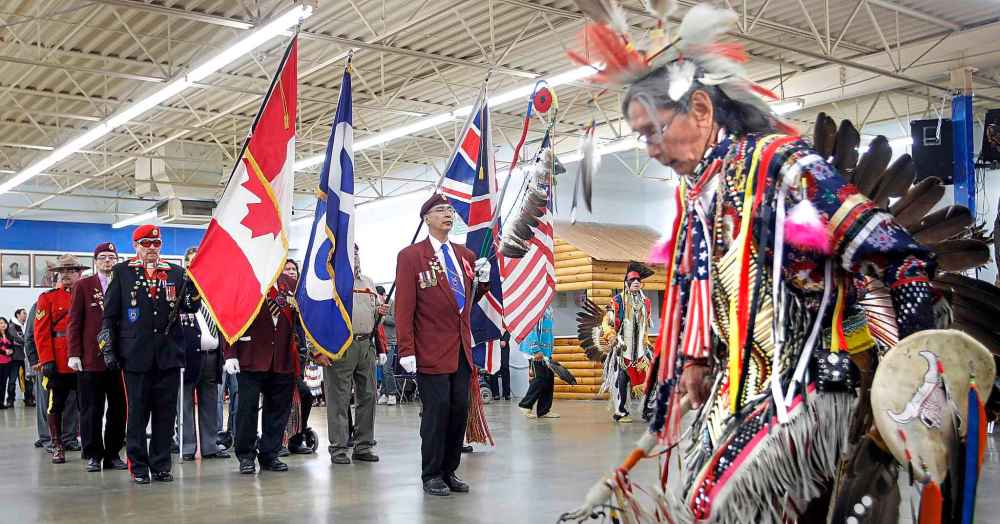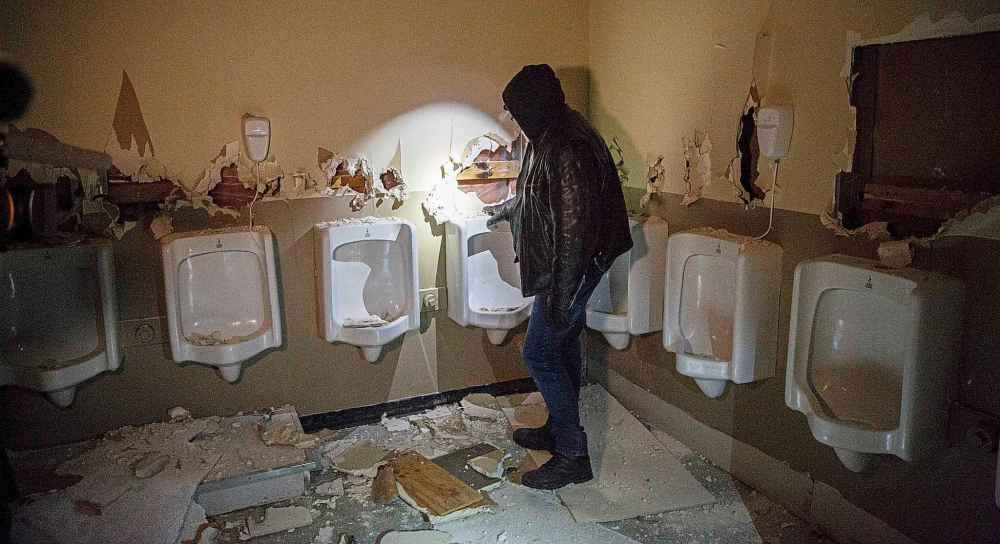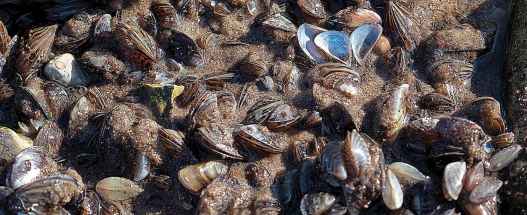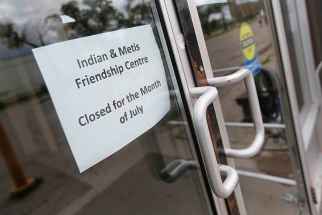With a proud past, friendship centre to rise again
Read this article for free:
or
Already have an account? Log in here »
To continue reading, please subscribe:
Monthly Digital Subscription
$0 for the first 4 weeks*
- Enjoy unlimited reading on winnipegfreepress.com
- Read the E-Edition, our digital replica newspaper
- Access News Break, our award-winning app
- Play interactive puzzles
*No charge for 4 weeks then price increases to the regular rate of $19.00 plus GST every four weeks. Offer available to new and qualified returning subscribers only. Cancel any time.
Monthly Digital Subscription
$4.75/week*
- Enjoy unlimited reading on winnipegfreepress.com
- Read the E-Edition, our digital replica newspaper
- Access News Break, our award-winning app
- Play interactive puzzles
*Billed as $19 plus GST every four weeks. Cancel any time.
To continue reading, please subscribe:
Add Free Press access to your Brandon Sun subscription for only an additional
$1 for the first 4 weeks*
*Your next subscription payment will increase by $1.00 and you will be charged $16.99 plus GST for four weeks. After four weeks, your payment will increase to $23.99 plus GST every four weeks.
Read unlimited articles for free today:
or
Already have an account? Log in here »
Hey there, time traveller!
This article was published 12/06/2019 (2372 days ago), so information in it may no longer be current.
In April 1959, the Indian and Métis Friendship Centre opened in downtown Winnipeg on the main floor of an office building. It housed offices, a lounge, rec room, kitchenette and a craft room.
At the time, there were fewer than 5,000 “Indians” in Winnipeg, and many more Métis. Most First Nation citizens were still locked on reserves, refused the right to vote, and lived under the brutal control of the Indian Act.
Change was coming, however, when the Indian Act was amended in 1960 and the Indigenous population of Winnipeg increased.

Indigenous life was not easy in the city. Many experienced difficulty finding suitable employment, decent housing, and access to health care. Most were residential school survivors with substandard education or, worse, they had experienced trauma as students. This resulted in a population with unique needs and no programs to address them.
A space was needed to help Indigenous peoples adjust to the city.
While the idea of creating the friendship centre was driven by Indigenous peoples, it was predominantly non-Indigenous people with money, power, and influence who helped them do it. The first friendship centre began with a $3,500 grant from the Winnipeg Foundation, some government funding, and a board of directors that was largely non-Indigenous. The first chairman was Canon E.W. Scott, who would later become head of the Anglican Church of Canada.
The visionaries who continued to build the friendship centre included a who’s who of Indigenous leaders, artists, and business leaders. They were people like Marion Meadmore, the first female Indigenous lawyer in Canada; Marie Baker, a nationally renowned poet; Amy Clemons, an Order of Canada recipient; and Cyril Keeper, one of the first Indigenous MPs in Canada.
By 1967, the friendship centre had grown so much that it moved to 73 Princess St. from 376 Donald St.
It was helped by a new political group called Club 376, which was headed by future leaders such as Tom Jackson, the Juno-award winning singer; Allan Chartrand, who worked for Manitoba Highways; Ovide Mercredi, the future national chief of the Assembly of First Natios; Louise Chippeway, who helped guide the 1996 Royal Commission on Aboriginal Peoples; and George Munroe, one of the first Indigenous city councillors in Winnipeg.
The early 1970s saw a massive expansion as the friendship centre initiated projects to combat poverty and homelessness. It began programs such as Kinew Housing, Main Street Project, and Neeginan, while investing in the city, buying the former Winnipeg Badminton Club at 150 River Ave. and turning it into the Winnipeg Native Club for sports and social activities. The centre expanded again and moved to 590 Main St. By this time, it employed eight staff and served more than 10,000 citizens.

The later 1970s saw it continue to grow as a force in Winnipeg. Volunteers began a restaurant called Bungees, ran summer programs for children, and founded a women’s emergency shelter, which later became the Native Women’s Transition Centre. The friendship centre moved to 465 Alexander Ave. and provided instrumental leadership and resources to help organizations such as Rossbrook House and the Manitoba Association of Rights and Liberties get started.
By the 1980s, the friendship centre employed more than 30 people and provided services to more than 30,000 citizens annually.
It continued its work into the 1990s, moving to its current location at 45 Robinson St. in 1992. It was now the central hub for Indigenous life in Winnipeg. It was largely self-supporting economically through fundraising and bingos and it hosted most of the important Indigenous forums and people in the city. The centre even created an Indigenous Wall of Fame to honour past contributors.
Former executive director Mary Richard would join other alumni to create the Aboriginal Council of Winnipeg and, later, help create Thunderbird House.
By the time I walked through its doors, the centre was feeding, training and helping thousands every week.
Without it, there would be little of the economic and social development in the North End and much of the rest of the city we know today. Many organizations have been the veins of development, but the friendship centre was more like a heartbeat, producing thousands of Indigenous political and cultural leaders, hundreds of thousands of dollars of investment, and one of the most important spaces for Indigenous and non-Indigenous peoples to meet, share, and grow together.
In short, it embodied reconciliation long before it became a buzz word.

I know. I, too, am a product of the friendship centre. I’ve attended ceremonies there, worked there, played bingo there, and had family members saved by its programs.
That makes what’s happened in the past few years so tragic.
You see, the centre, which had a large hand in building Winnipeg, has been forgotten by our city. With the Indigenous population of Winnipeg the highest it’s ever been, our most important institution appears to be lost.
The past few years have seen it fall into political disarray, lose volunteers and partners, and finally close its doors after having its funding suspended by the Manitoba Association of Friendship Centres in 2017.
In early 2019, vandals ransacked and looted the building. Some community members claiming to be board members announced a re-opening that never happened. This past month, news emerged that the centre is tens of thousands of dollars in debt. There is little hope left. The promise of the past seems to be dead.
Currently, all that protects the empty building on Robinson Avenue are regular visits by the Bear Clan Patrol.
But it’s not over.

In late 2018, two groups called Aboriginal Visioning for the North End and the Winnipeg Indigenous Executive Circle met with representatives from Ma Mawi Wi Chi Itata Centre to come up with a new vision. They proposed to the Manitoba Association of Friendship Centres that they re-create the centre and – if the site cannot be saved – find a new site.
On June 9, their proposal was approved unanimously.
In an email to the partners, Ma Mawi Wi Chi Itata executive director Diane Redsky announced there will be a meeting “immediately” to “establish the governance” and “oversee the programming” of the new Winnipeg Friendship Centre.
Who wants to help them?

Niigaan Sinclair is Anishinaabe and is a columnist at the Winnipeg Free Press.
Our newsroom depends on a growing audience of readers to power our journalism. If you are not a paid reader, please consider becoming a subscriber.
Our newsroom depends on its audience of readers to power our journalism. Thank you for your support.











